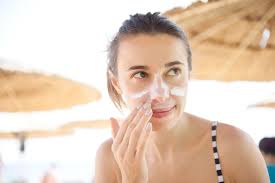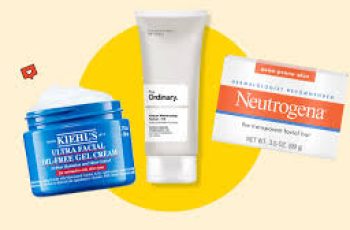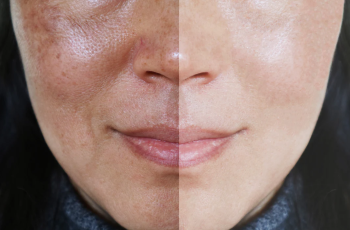
The Science of Iron Oxide in Skin Care
Chances are, you’ve used a skincare or cosmetic product that contains iron oxide without even realizing it.
Iron oxides are commonly found in tinted sunscreens, foundations, and makeup products, often serving as a natural colorant.
While their primary role is to provide pigment, they also come with a few important skin benefits, including blocking harmful blue light from penetrating the skin and helping prevent melasma and other forms of hyperpigmentation.
Before deciding whether products containing iron oxide are right for you, it’s important to understand your unique skin needs.
Make sure to take the Baumann Skin Type quiz to determine which of the 16 skin types you belong to, and then use this guide as a resource for incorporating iron oxide into your skincare routine.
What Is Iron Oxide?
Iron oxides, also known as ferric oxides, are naturally occurring minerals found in a range of colors, but red iron oxide is the most commonly used in cosmetic products.
These pigments are made from the combination of iron and oxygen and are widely used for their stable color and non-toxic properties.
In cosmetics and skincare, iron oxides are most often used as pigments to add a natural tint to various products.
Iron oxide pigments are UV-stable and resistant to oxidation, meaning they maintain their color even when exposed to sunlight.
This makes them an excellent addition to products that will be worn throughout the day.
The iron oxides used in cosmetics are carefully processed to remove any impurities, ensuring that they are safe for use on the skin.
There are three main types of iron oxide pigments used in skincare and cosmetics:
CI 77491 (Red Iron Oxide): Commonly used to add a red or brown tint to products.
CI 77492 (Yellow Iron Oxide): Provides a yellow or golden hue.
CI 77499 (Black Iron Oxide): Used to create darker shades, often found in eyeliners and brow products.
These pigments are an essential ingredient in many sunscreens, foundations, BB creams, and other tinted products.
They contribute not only to the cosmetic color of the product but also to its effectiveness in protecting your skin.
Skin Benefits of Iron Oxide
While iron oxides are most commonly recognized for providing tint to cosmetic products, they offer a number of additional skin benefits.
Let’s explore the key advantages they bring to your skincare routine.
1. Blocks Blue Light
Blue light is emitted by the sun and artificial light sources like computers, smartphones, and LED lights.
This light has short, high-energy wavelengths that penetrate deeper into the skin compared to traditional UV rays.
Blue light can stimulate melanocytes (the cells responsible for producing melanin), leading to hyperpigmentation, dark spots, and conditions like melasma.
Iron oxides form a physical barrier on the skin, effectively blocking and reflecting blue light, thereby reducing its impact on skin cells.
By preventing excessive blue light exposure, iron oxides help reduce the stimulation of melanocytes and, in turn, prevent pigmentation issues.
2. Helps Prevent Melasma
Melasma is a type of hyperpigmentation that causes dark, uneven patches of skin, usually on the face. It is commonly triggered by sun exposure, but blue light has also been shown to worsen melasma.
As blue light exposure increases, it can trigger melanin production and make melasma patches darker and more pronounced.
Iron oxide’s ability to block blue light makes it an excellent ingredient in products aimed at preventing or treating melasma.
Tinted sunscreens and foundations with iron oxide can help protect the skin from the harmful effects of blue light, reducing the risk of melasma worsening or recurring.
Dermatologists like Dr. Leslie Baumann often recommend these tinted sunscreens to patients with melasma or those concerned about pigmentation issues.
3. Antioxidant Protection
Certain iron oxide nanoparticles possess antioxidant properties, which means they can help reduce oxidative stress in the skin.
Oxidative stress occurs when free radicals (unstable molecules) damage skin cells, leading to premature aging and the breakdown of collagen.
By neutralizing these free radicals, iron oxide can offer an extra layer of protection against the environmental factors that contribute to fine lines, wrinkles, and sun damage.
Studies have suggested that iron oxide’s antioxidant properties can help shield the skin from UV rays and pollution, both of which contribute to oxidative stress.
This added protection is especially beneficial for individuals with mature skin or those living in urban environments where air pollution is a concern.
Side Effects of Iron Oxide
Iron oxide is considered safe for cosmetic use, and it has a low hazard rating on the Environmental Working Group (EWG) Skin Deep database.
It is non-irritating and generally well-tolerated by most skin types, including sensitive skin.
Unlike many chemical sunscreens and synthetic dyes, iron oxides are non-comedogenic, meaning they won’t clog pores, making them safe for individuals with acne-prone skin.
However, like with any cosmetic ingredient, there is always a small risk of an allergic reaction.
Though rare, some individuals may experience irritation or sensitivity to certain iron oxide pigments, especially if they have an allergy to other mineral pigments.
It’s always a good idea to patch-test a new product before using it extensively on your skin.
Overall, iron oxide is a gentle and effective ingredient in skincare products and has a solid safety profile.
Iron Oxide in Sunscreens
Mineral sunscreens, also known as physical sunscreens, are becoming increasingly popular due to their ability to provide broad-spectrum UV protection without the use of potentially irritating chemicals.
These sunscreens typically contain zinc oxide and/or titanium dioxide, which work by physically blocking UV rays from penetrating the skin.
However, one challenge with mineral sunscreens is that they often leave a white cast on the skin, especially in individuals with darker skin tones. This is where iron oxide comes in.
Iron oxide can be added to mineral sunscreens to provide a natural tint that helps to blend the product more seamlessly into the skin, reducing or eliminating the white cast.
Tinted sunscreens with iron oxide provide dual protection against both UVA and UVB rays while also offering blue light protection, making them a great choice for those concerned with pigmentation issues like melasma.
Some of the best mineral sunscreens that contain iron oxide include:
Colorescience Sunforgettable Total Protection Brush-On Shield SPF 50: This product contains a blend of iron oxides for tinted protection and is available in multiple shades.
EltaMD UV Daily Tinted Broad-Spectrum SPF 40: This sunscreen offers a subtle tint from iron oxide, providing extra protection from both the sun and blue light.
La Roche-Posay Anthelios Mineral Tinted Sunscreen SPF 50: This tinted sunscreen contains both iron oxides and mineral-based sunscreens for a smooth, non-greasy finish.
Iron Oxide in Makeup
Beyond sunscreens, iron oxide is also widely used in makeup products, including foundations, BB creams, concealers, and blushes, to provide natural and flattering color.
The advantage of iron oxide in makeup is that it provides long-lasting color without the need for synthetic dyes, making it ideal for sensitive skin types.
Although makeup containing iron oxide can offer some degree of sun protection, it’s important not to rely solely on makeup for full UV protection.
To ensure your skin is fully protected from both UVA/UVB rays and blue light, it’s best to layer makeup with an SPF sunscreen underneath.
Alternatively, you can use a tinted sunscreen as a base before applying your makeup.
Bottom Line
Iron oxide is a versatile ingredient commonly found in sunscreens and makeup products.
In addition to providing a natural tint, it offers important blue light protection, helps prevent melasma, and provides antioxidant protection against environmental stressors.
By incorporating iron oxide into your skincare routine, you can protect your skin from both UV radiation and the harmful effects of blue light, which is especially important for those with pigmentation concerns.
If you’re looking for a sunscreen or makeup product that helps prevent pigmentation and provides dual protection from the sun and blue light, look for products that contain iron oxide.
And, as always, make sure you select a product that’s right for your Baumann Skin Type to ensure you achieve the best results.
To get personalized recommendations tailored to your skin type, take the Baumann Skin Type quiz for free today!


